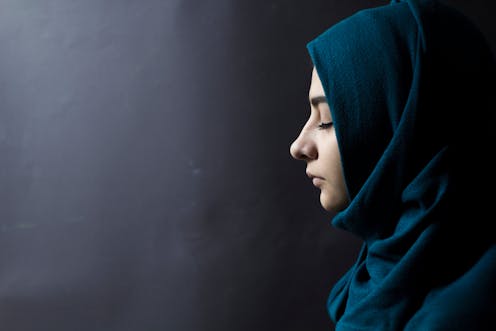new research shows Islamophobia continues at disturbing levels in Australia
- Written by Derya Iner, Senior Lecturer, Charles Sturt University

Today we release the third Islamophobia in Australia report[1]. We are doing this on the third anniversary of the Christchurch terror attacks to once again highlight the ongoing threat to Muslim people in their everyday lives.
This report is based on incidents reported to the Islamophobia Register Australia[2] by victims, proxies and witnesses during 2018 and 2019.
This includes 247 verified incidents (138 physical and 109 online). It follows 349 incidents in the second report[3] (published in 2019) and 243 incidents in the first report [4](published in 2017).
Although the analysis of reported cases may not represent all incidents occurring across Australia, they remain a critical and valuable source for understanding manifestations of Islamophobia in the Australian context.
Men attacking women
The third report found perpetrators were predominantly men (74%), while victims were predominantly women (82%). Of the 103 victims, 85% were women wearing hijab, 15% were children and 15% were women with children.
A Queensland woman reported she was yelled at when walking past three young boys.
I was with my two small children and they started saying ‘let’s rip it [her hijab] off her head!’ I quickly got nervous and started pacing to get away with my children before the incident escalated. Alhamdullilah [thank God] we made it to safety before anything serious happened.
Another woman reported this comment after the Christchurch massacre:
I have had the father of my eldest daughter friend say to me directly […] ‘the Muslims had it coming’. I was shocked and could only stare back in disbelief. The daughter of that gentleman would call me ‘ghost’ in front of myself and my daughter, referring to my hijab/scarf.
Perpetrators were overwhelmingly Anglo-Saxon (91%) and they were mostly aged in middle and late adulthood (57%). In contrast, victims tended to be in early and middle adulthood (61%).
In most cases, the victim was alone with the perpetrator (54%), and in one in five cases, there was an existing relationship between the perpetrator and victim such as a work (10%), school (5%) or social (3%) relationship.
According to the reported incidents, the perpetrator profile was diverse, ranging from homeless people to university staff and art gallery visitors. Some perpetrators carried out hate while in the presence of their own families, showing how socially acceptable this form of racism can be.
Where is safe?
The location of incidents showed anti-Muslim harassment often happens in crowds and busy public places (63%).
Since incidents were first logged in 2014, reports of anti-Muslim abuse have risen in areas with security guards and surveillance cameras – from 37% in the first report to 75% in the present report.
Read more: Islamophobic attacks mostly happen in public. Here's what you can do if you see it or experience it[5]
Incidents occurred in places including shopping centres, public transport, pools and playgrounds and education settings. This suggests there is no public space that is safe from Islamophobia.
Christchurch’s impact
The abuse Muslims suffer is centred on the unfounded and highly offensive idea that Muslims are “terrorists” and “killers” – this is despite Muslims suffering from white supremacist terrorism in the Christchurch attacks.
Unfortunately, in the wake of the Christchurch massacre, the Islamophobia Register Australia saw a spike in reporting of offline and online incidents. Reports of offline cases increased four fold - this included ten mosque vandalism cases.
Reports of online cases increased 18 fold within the two weeks of the attacks.
Especially in online platforms, sympathisers with the Christchurch terrorist justified or glorified his attack, called for more deadly and bloody attacks on Muslims or declared their willingness to follow the Christchurch terrorist by killing Australian Muslims once a “civil war” starts in Australia.
Along with this hyper-violent rhetoric, we saw an escalation in xenophobic language, from telling people to “go home” to expressing supremacist conspiracies such about a “demographic invasion by Muslims”. These xenophobic attacks was the most popular form of online hate rhetoric (43%) after associating Muslims with terrorism (58%).
Not a ‘Muslim’ problem, a social cohesion risk
The Islamophobia report is yet more evidence of the abuse Muslims face in Australia - just for going about their lives.
Positive action from our political leaders is required to safeguard the dignity, equality and safety of every citizen and minority group, including Muslim Australians.
Read more: Two years on from the Christchurch terror attack, how much has really changed?[6]
The increase in Islamophobia in the aftermath of the Christchurch attacks is not a coincidence. The incitement to violence on social media suggests the need for intense monitoring and strategic moves by counter-terrorism organisations.
Islamophobia is not a “Muslim” problem, it is a risk to our social cohesion. It requires national engagement if Australia is to live up to its multicultural legacy.
References
- ^ Islamophobia in Australia report (www.isra.org.au)
- ^ Islamophobia Register Australia (www.islamophobia.com.au)
- ^ second report (researchoutput.csu.edu.au)
- ^ first report (researchoutput.csu.edu.au)
- ^ Islamophobic attacks mostly happen in public. Here's what you can do if you see it or experience it (theconversation.com)
- ^ Two years on from the Christchurch terror attack, how much has really changed? (theconversation.com)

















